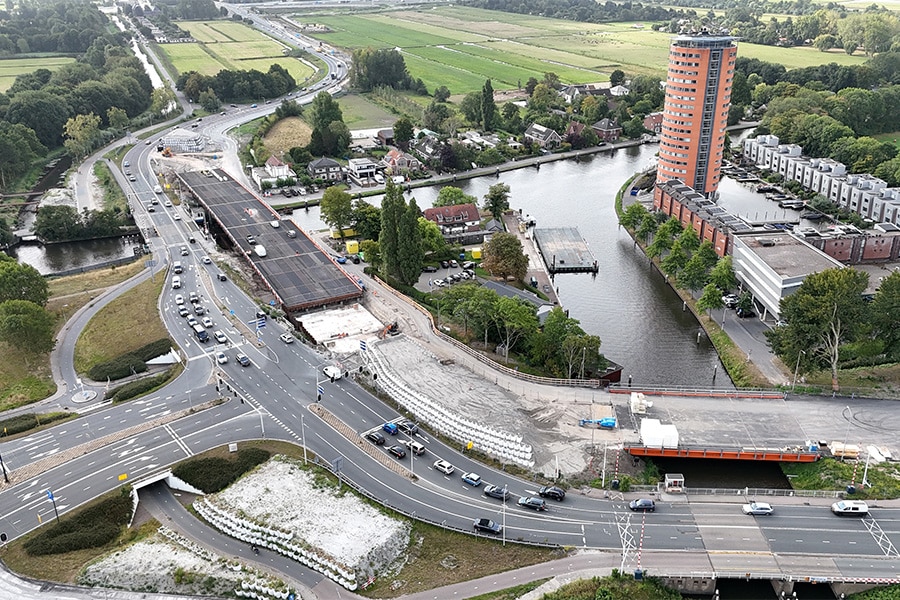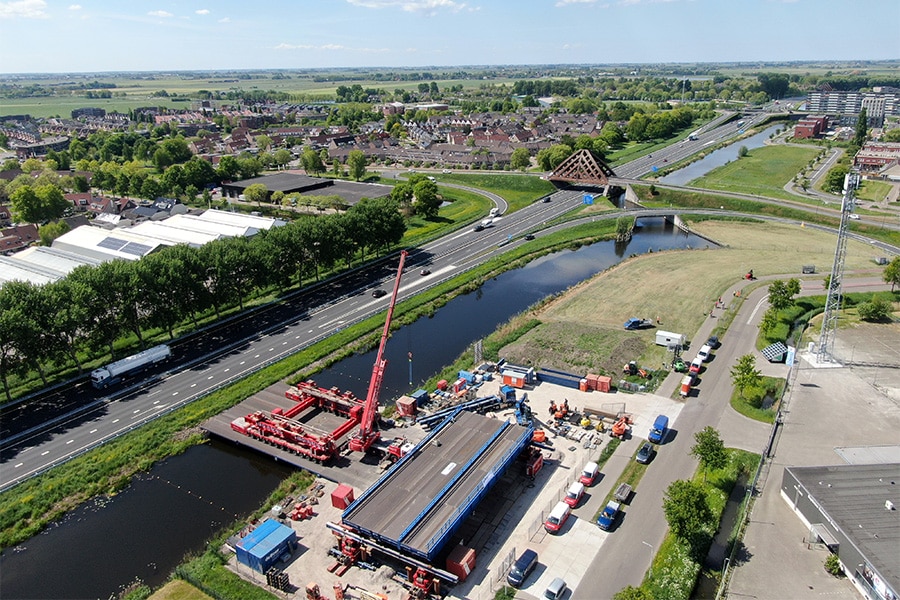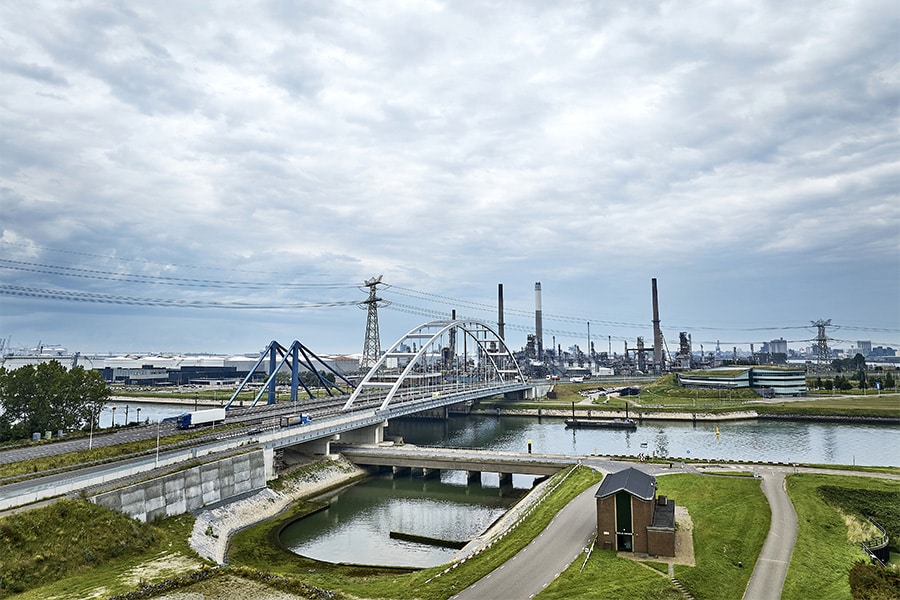
The power of monitoring for life extension of civil engineering structures
The Dutch infrastructure sector faces an immense challenge: maintaining and renewing outdated bridges, viaducts and underpasses. Replacing them all, there is no budget for that. Moreover, it's not exactly a sustainable choice either. Part of the solution to the large-scale Replacement and Renovation (V&R) task lies in the power of monitoring, as Fugro has proven, for example, on the Suurhoff road bridge in the A15 and the railroad bridge over the Gouwe Canal near Alphen aan den Rijn.
Much of the civil infrastructure in the Netherlands was built in the 1960s and 1970s. "These structures are now fifty to sixty years old and are reaching the end of their theoretical lifespan," says Edo Noordermeer, a consultant at Fugro. "Replacing all of them is madness. Apart from the budget being insufficient, in many cases it is also unnecessary. Many engineering structures can basically last for many decades, but of course you want to know for sure, because there are also engineering structures that do need to be reinforced or, in the worst case, completely replaced."
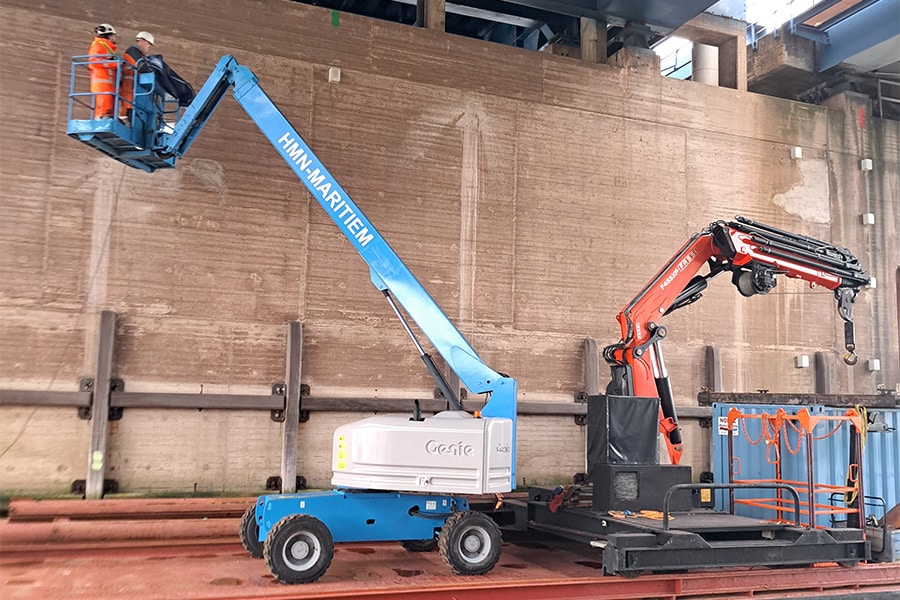
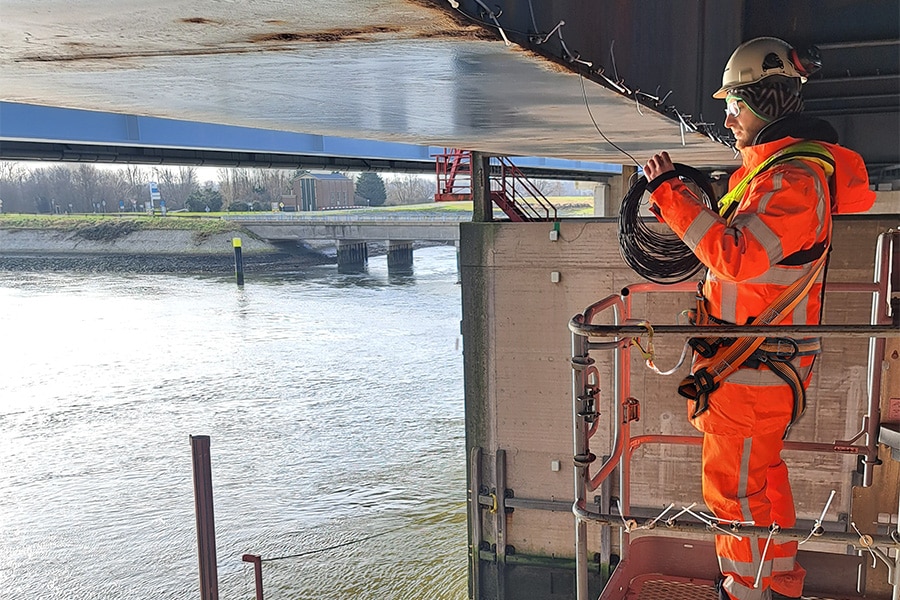
Suurhoff road bridge. (Image: ANP Hollandse Hoogte - Siebe Swart)
Technical profession no longer in demand
"Aging is only one aspect that works of art 'suffer' from," according to Edo. "The second aspect is the increased traffic load and intensity, which is now much higher than what a structure was calculated for at the time. Whereas a 30-ton transport used to be a lot, now 100-ton transports regularly pass over a structure. That can really be an issue for bridges. And the third factor is that traditionally much reliance has been placed on periodic inspections of structures by experts. That is a technical profession that is no longer in demand. Many experts are retiring and recruitment is way down. So there is a growing shortage of people with the right expertise. One of the solutions for all these factors together is automated measurement and monitoring. We notice from Fugro that there is increasing demand for this."
Permanent versus periodic
When a bridge reaches the end of its theoretical life, a structural recalculation is done. Based on the available information about the condition of the structure and the current use load, an assessment is made of the actual residual life. However, assumptions must always be made here and conservative margins are maintained to control uncertainties. Full utilization of the service life can be achieved by refining the assumptions, based on additional research or better models, or by monitoring a structure with sensors and setting limits for the measured values within which the structure can still safely remain in use. Fugro does the latter, for example, on the railroad bridge over the Gouwe near Alphen aan den Rijn. "The big advantage of sensors is that you monitor permanently," says Edo. "Visual inspections by definition take place only periodically, often only once a year and even in the most critical cases only weekly or monthly.
With sensors, on the other hand, you can monitor at a much higher frequency, from hours, minutes, to even seconds depending on the sensor technology chosen. This gives much more information about the behavior of the structure and the potential risks. By continuously monitoring bridges and viaducts, we can accurately determine which structures are still safe and serviceable, and which ones actually need replacement and/or renovation. This avoids spending precious resources on the unnecessary replacement of structures that can still be used in a controlled manner for years to come, while ensuring that safety remains assured."
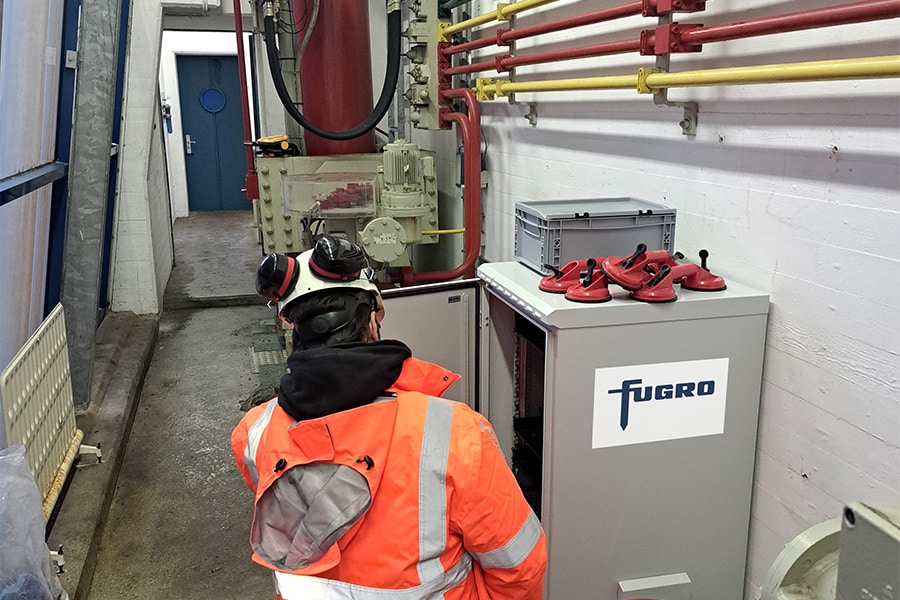
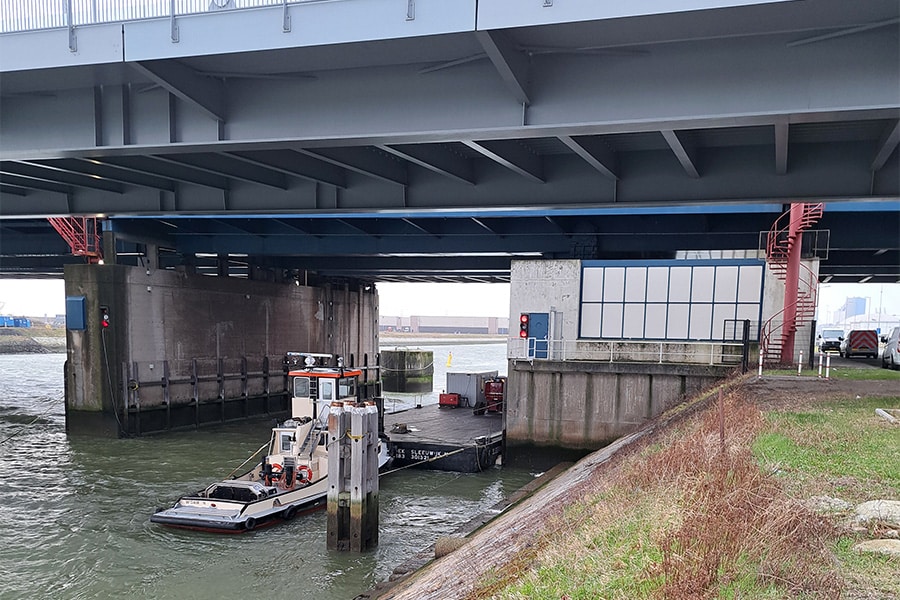
Installation of the monitoring system controls in the old section of the bascule bridge.
Strain measurements Suurhoff Bridge
Commissioned in 1974, the Suurhoff Bridge is the gateway to the Maasvlakte. This bridge is scheduled to be replaced, but the existing bridge must remain in safe use until then. In 2021, therefore, the structure was renovated. As the first bridge in the Netherlands, the Suurhoff Bridge was reinforced with a new technique by Arup, in which steel plates are attached to the road surface with epoxy glue as well as bolts. "Arup wanted to test this new innovative method, which can be applied with relatively little effort, in practice. Of course you want to validate the effect of this new technique. How does the reinforcement behave over a longer period of time," says Hans Redder, project manager at Fugro. "We made a plan together with Arup and determined the type of measurement technique. At specific points under the road surface, we take strain and temperature measurements with fiber bragg grating (FBG) glass fiber sensors. This allows us to determine how well the reinforcement is functioning and whether the reinforcement can withstand the traffic loads and temperature differences that occur during different seasonal conditions in the long term."
State-of-the-art technology
Fugro is providing the monitoring of the Suurhoff Bridge for a period of three years. "In February 2024, the monitoring system was installed, consisting of 26 sensors for strain measurements and three temperature sensors. "They were all placed under the bridge deck within two weeks, from a pontoon with an aerial platform," Hans outlines the installation work. "The advantage of fiber optic technology is that you don't have to deal with distortions or weakening of the signal over long distances. Traditional techniques are disrupted by large temperature changes. Under the bridge deck, the temperature can quietly rise to fifty degrees Celsius or more when the sun is full on the road surface. So with fiber optic technology, you can be sure that the installation will keep running properly for three years without intervention. And that's also worth something, especially given the difficult accessibility under the bridge deck." Although the sensors are located under the bridge deck, the controls are placed nice and dry in the old part of the bascule bridge. All the data is displayed on Fugro's VirGeo® cloud platform. "Every quarter over a two-week period, we also do high-frequency measurements up to 100 Hertz. It's great to be working with state-of-the-art technology in such a historic bridge." "With this monitoring, we examine the applied reinforcement and can validate that the new reinforcement method is the best for steel bridges with fatigue problems," said engineer Bram Buts, technical manager at Rijkswaterstaat. "With this, the new reinforcement method can become a standard for our field of work."
Railroad bridge near Alphen aan den Rijn
"The railroad bridge at Alphen aan den Rijn is a single-pile swing bridge in canal the Gouwe," says Frank van der Kroon, project manager at Fugro. "The bridge swings open for boating traffic and then turns back so that train traffic can continue. The latter situation does require the rails to be precisely aligned with the abutments. The whole thing has very little tolerance for deviation to prevent the bridge from malfunctioning and causing train disruption. The foundation of this railroad bridge has been subject to settlement in the past. To monitor the risks of further settlements in the future, both the position of both abutments and that of the center pillar are continuously monitored by a robotic total station (RTS). With the RTS, we measure four prisms on each of the three structural parts twice during one measuring cycle. Such a measurement cycle takes fifteen minutes. So every hour we determine the current position four times. In this way, we can detect deviations quickly and accurately."
TotaLite®
With aging civil engineering structures and a changing climate, damage and risks due to (unwanted) deformations are expected to increase in the coming years. The RTS system excels in precision and reliability, but is not widely applicable due to cost and applicability. RTS systems are large, require a fixed power supply and are susceptible to theft - as a result, Fugro has lost several RTSs in recent years. Still, there is a need for reliable automatic deformation measurements. For this reason, Fugro went in search of an innovative solution, TotaLite®. It is a new measuring technique where deformations are monitored very precisely on the basis of a camera. The advantage of this technology is that it is a cheaper and easier method for long-term automatic monitoring of civil engineering structures. At the railroad bridge in Alphen aan den Rijn, TotaLite® is being tested in parallel with the RTS. This innovation has now been validated for the applications of tunnels and buildings, but further development is needed to achieve the required sub-millimeter accuracy in weather and wind in complex projects where deformations are a risk, as with this railroad bridge. Edo: "These kinds of developments are long-term innovation processes. The step from measuring in the laboratory to outside in the field is just very big. It is therefore important to test the technique in practice and deploy it simultaneously on several projects. Findings from this pilot will help to continuously improve the technology and make it widely deployable."
Precursor
Technological advances in monitoring structures are moving very fast. "Only five years ago, sensors were less suitable for the type of monitoring we are now performing on the Suurhoff Bridge and the railroad bridge over the Gouwe River," Edo says. "There have also been very big steps in terms of data processing. We are constantly looking around us at what sensors and techniques are being developed by third parties and how we can best use them. Fiber optics is a good example of that, and relatively new for an application to this kind of structure. We as Fugro are definitely pioneers in this field. After all, many strain measurements are still performed with traditional electrical equipment. We also continue to develop our own sensors and systems. Systems that are much cheaper and easier to install and have low power consumption. So that, because of safety, we physically have to spend less time on a structure in the road or on the railroad."
Thanks to smart monitoring techniques from Fugro, managers can extend the lifespan of their civil engineering structures, allowing them to responsibly postpone expensive replacements. Together we are working towards a safe and livable world, so that our infrastructure remains reliable in the future.
Alphen aan den Rijn railroad bridge
Last October 11, a collision occurred between a barge and the railroad bridge near Alphen aan den Rijn. The ship got stuck under the bridge and train traffic was blocked for hours. Even in an incident like this, the monitoring system provides valuable information. The RTS system was not hit in the collision, so the measurements continued as usual during the incident. Based on the measurements, even before the bridge closed again, ProRail was able to determine that at least the foundation of the center pillar had not suffered any damage. This information helped to clear the bridge for train traffic more quickly. "Because of the monitoring data, we immediately had clarity about the impact on the foundation; without that information, the decision-making process would have been more difficult and the railroad bridge's stoppage could have lasted longer," said Reinier Kleissen, system specialist for structures at ProRail.
Heeft u vragen over dit artikel, project of product?
Neem dan rechtstreeks contact op met Fugro.
 Contact opnemen
Contact opnemen
